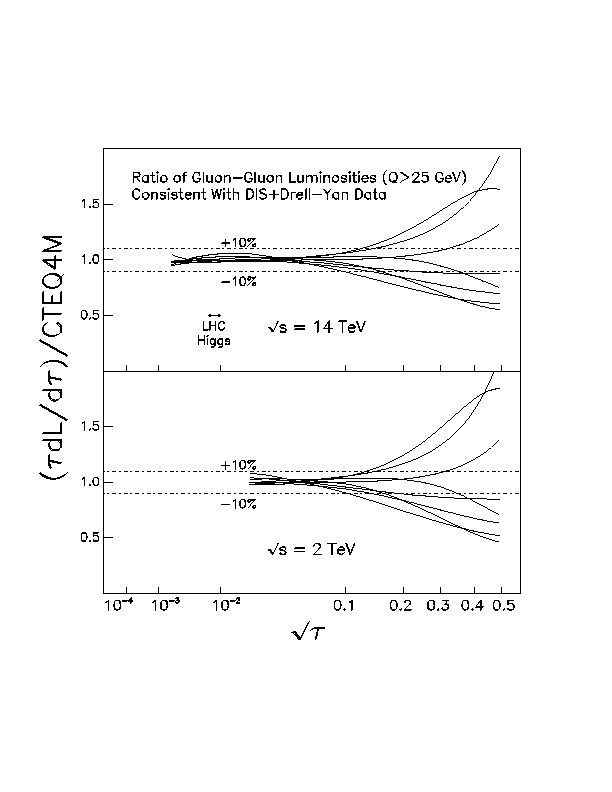Determining the gluon distribution
J.F. Owens, Florida State University
One of the prerequisites for performing perturbative QCD calculations for
collider processes is knowledge of the momentum distributions of the partons
in the colliding hadrons. Such distributions are usually obtained by global
fits to data for a variety of processes. In such fits, the quark distributions
are strongly constrained by data for deeply inelastic scattering and lepton
pair production (see determining the flavor dependence
of pdf's). However, the gluon distribution, especially at large values of
the momentum fraction x, is still rather uncertain ( Huston et al., 1998 ).
 This situation has arisen
primarily because there are few observables which are dominated by
parton subprocesses involving initial state gluons, and those have some
theoretical problems. Examples include direct
photons and jets. Improvements in our theoretical
understanding of these two processes would go far towards reducing the
uncertainty in the gluon distribution.
This situation has arisen
primarily because there are few observables which are dominated by
parton subprocesses involving initial state gluons, and those have some
theoretical problems. Examples include direct
photons and jets. Improvements in our theoretical
understanding of these two processes would go far towards reducing the
uncertainty in the gluon distribution.
Given the above situation, much of our knowledge of the gluon distribution
comes indirectly from scaling violations generated according to the DGLAP
evolution equations and from the momentum sum rule which constrains the
momentum fractions carried by all flavors of partons to add up to one.
Discussions of these
topics can be found in the CTEQ Handbook of Perturbative QCD.
The situation at smaller values of x is less of a problem, since strong
constraints are provided by the low-x DIS data, especially those from HERA,
as a result of the scaling violations referred to in the previous paragraph..
The uncertainties in gg and gq luminosities have been estimated in the
reference given above (
Huston et al., 1998 ).
Improvements in our knowledge of the gluon distribution at large values of x
can be made in at least two ways: (1) improve the calculation of direct photon
production and high p_T jet production and (2) investigate other processes.
One possibility is to study the Feynman x dependence
(x_F= 2 p_l/sqrt(s) where p_l is the longitudinal momentum) of J/Psi
production. This was used in early global fits (Duke and Owens, early MRS),
but was dropped as NLO calculations were included in the fits. Recent progress
in calculating J/Psi production may make it worthwhile to reconsider this
process as a means of constraining the gluon distribution. Another
possibility is high mass lepton pair production (Berger,Gordon, and Klasen, 1998). When the transverse
momentum of the pair is of the order of the pair mass, the QCD Compton
process (q g --> ll + q) plays a significant role and can be used to help
constrain the gluon distribution.
Comments on this entry may be sent to
J.F. Owens.
 This situation has arisen
primarily because there are few observables which are dominated by
parton subprocesses involving initial state gluons, and those have some
theoretical problems. Examples include direct
photons and jets. Improvements in our theoretical
understanding of these two processes would go far towards reducing the
uncertainty in the gluon distribution.
This situation has arisen
primarily because there are few observables which are dominated by
parton subprocesses involving initial state gluons, and those have some
theoretical problems. Examples include direct
photons and jets. Improvements in our theoretical
understanding of these two processes would go far towards reducing the
uncertainty in the gluon distribution.